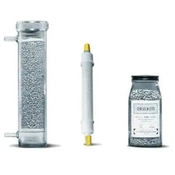Yes, I believe that keeping the sodium sulfite vessel in an ice bath would reduce the amount of water transferred. Cooling the 33% sulfuric acid would probably also help.
Granular anhydrous calcium sulfate is a good drying agent, and I doubt if it would react with SO2. It is the desiccant in the product product known as Drierite. There is an indicating form of Drierite that can be obtained that is blue when active and red when exhausted. If Drierite becomes exhausted it can be regenerated by spreading it out on a cookie sheet and heating it for an hour at 425F (Reference:
https://secure.drierite.com/catalog3/page19b.cfm). I don't think it would be necessary to use the indicating form if one simply regenerated the anhydrous calcium sulfate prior to each use.
I think the best way to use a desiccant like Drierite would be to pack it into a column. A couple of examples are shown in the attached image. You can buy columns packed with Drierite, but I'm sure that one could make a DIY column without too much trouble.
You might be able to make granular anhydrous calcium sulfate, starting with the dihydrate of calcium sulfate in powdered form. I won't go into that in detail right now, partly because I don't know the specifics. However, I think a basic process might be to make the a plaster, let it harden/dry, break it up into granules, sift the granules (to get rid of the powder), and heat the granules to convert them anhydrous calcium sulfate.
Gypsum is one form of calcium sulfate. It is the main ingredient in sheetrock, although sheetrock contains other additives as well. However, I suspect that the other additives would probably not interfere with a DIY desiccant made from the core of some discarded sheetrock using a process similar to the one I outlined above. Of course I am somewhat guessing here.
I have focused on calcium sulfate disiccant here. There are other desiccants as well.
A cold trap is another possibility that might work as a substitute for a desiccant column or as an adjunct to a desiccant column (
https://en.wikipedia.org/wiki/Cold_trap). Note: an earlier form of this post discussed a cold finger instead of a cold trap. A cold trap is what should be considered, not a cold finger. The two devices are closely related. One might think of a cold finger as an inverted cold trap.
All of this assumes that some water in the home-brew HC-110 would pose a problem. There are reasons to assume that a little bit of water wouldn't hurt the lifetime very much, but I don't know for sure. However, if it turned out that a little bit of water in the HC-110 was no problem then obviously it probably makes no sense to go to great lengths to prevent a bit of water contamination.












